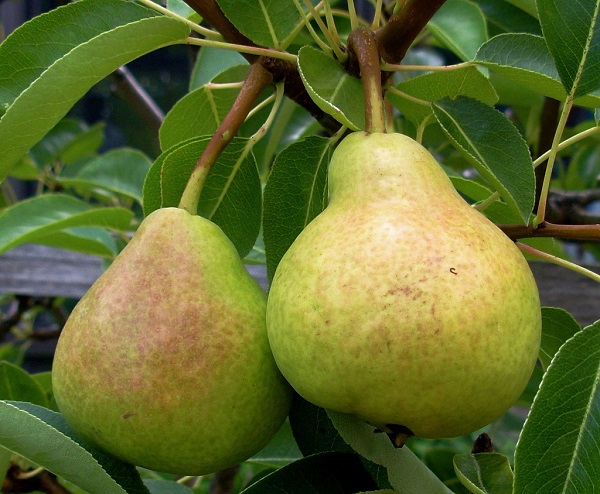In addition to taste, pear is famous for its beneficial properties. Variety pears Veles different from other varieties of its delicious fruits and ease of care.
Table of contents
Description of the variety
Let's start with a description of the variety. The Veles pear tree is the result of the crossing of the Forest Beauty and Venus varieties, the second name of the Daughter of Excellent variety. Worked on the breeding of a new variety N.V. Efimova and Yu.A. Petrov. Velez immediately interested many gardeners, and for good reason. Smooth, with thin skin, a beautiful shape of the fruit, Veles pear has excellent taste. Fruits are sweet, fleshy, juicy, with a pleasant aroma.
Fruits of a pear change color, fruits of green-lime shades in the middle of summer, change to yellow closer to August. That, the side of the pear, on which the sun's rays fall, acquires orange-red tones, and the side in the shadow remains green. Because of such metamorphoses, pears look very beautiful and unusual. In addition, the fruits are large, have the shape of a flashlight, a narrow part of the pear at the top, round at the bottom. One pear can weigh up to 200 grams!
Pear Veles refers to the autumn varieties. The tree blooms in spring, white, fragrant buds. Fruits form during the summer, fruit ripening begins in early August.
You can pick ripe fruits in early September, but ... The pear variety is beautifully stored in the harvested state until winter.And if you need to keep the fruits until the cold, then it is worth picking a pear when it is hard, carefully removing the fruit from the tree without damaging them. Damaged fruits (fallen or with dents on the skin) quickly rot and are not suitable for storage.
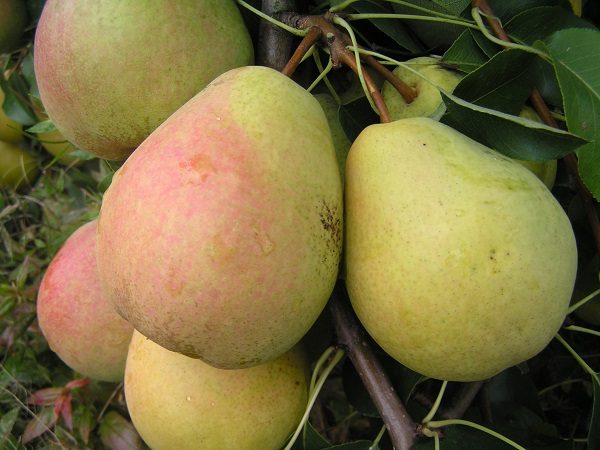
In order for pear fruits to be kept until spring, it is better to put them in a box, and each fruit should be wrapped in a newspaper.. So, the pear can be stored in a cool place for several months.
In itself, a tree with a height of more than 4-5 m with a thick and brownish trunk. Branches sprawling, curved, medium thickness, gray-brown. The leaf plate in an adult tree is dark green in color; young leaves have a light green color.
Advantages and disadvantages
The variety has a beautiful view, which makes it attractive for sale. The tree is also resistant to various diseases and pests, not afraid of cold weather and severe weather. The harvest brings every year, does not need a "rest", besides the number of fruits increases every year.
But the variety has some disadvantages, for example, with a bountiful harvest, the fruit becomes smaller in size. This is easily eliminated with regular pruning. Also, there is a freezing of the kidneys during fruit ripening.
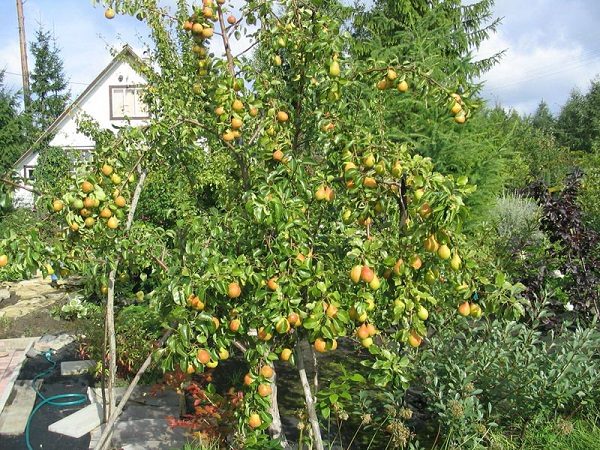
Diseases and pests
Mealy dew - the first signs of this disease are formations on the inflorescences, shoots and leaves of a white thin deposit, which eventually turns brown and leaves behind black dots. It is important to fight this problem before bud break, with Scor or Topaz. Before flowering, it is better to use Hom, but after harvesting it is worth spraying the tree with copper sulphate.
Fruit rot is often seen on fruit in the form of brown spots, therefore, the heart of the fruit turns brown. The fruits rot and become unsuitable for food. Before flowering a tree can be processed with Home, and after flowering, apply Oxy.
Often the pear is exposed to bacterial burns, the leaves of the tree turn black, and the annual shoots dry out. You can fight this disease with a solution of copper sulfate or with Hom. It is also important to cut off infected leaves and shoots and burn them.
Cracking bark is just as dangerous for a pear; cracks in the trunk make it more vulnerable to insects and other diseases. The usual solution of lime will save the tree from cracks in the crown.
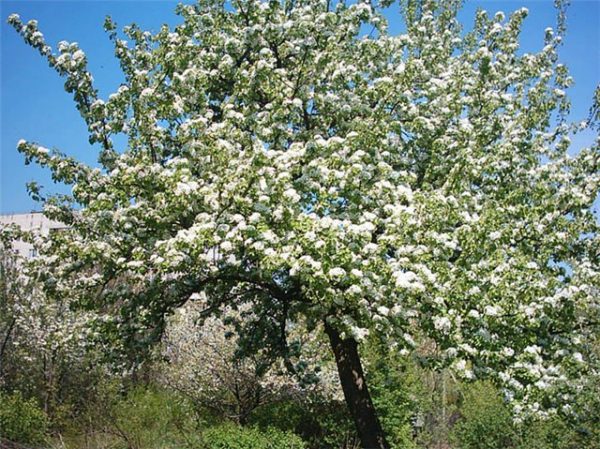
In addition to diseases, the pear "attracts" many pests. Among them stands hawthorn, which feeds on ovaries, buds and leaves of a tree, and is also capable of eating up young branches. Before budding, the tree must be sprayed with Carbofos or Entobacterin.
Medianica is a pest that causes yellowing of leaves. They twist and fall. Also the brawler eats flowers and leaves of a tree. You can fight it with the help of a solution Vermitek or Hom.
Moth causes falling off and rotting of fruits. To fight it you need drugs Apollo or Vermitek.
Landing
Choosing a place and time for landing
When choosing a place to plant a pear, it is important to remember that a pear is a thermophilic plant, therefore it is necessary to plant it on a light plot, not only tree growth, but also the level of sugar content of fruits depends on it. It is also not necessary to plant a pear on the open areas, the wind has a negative impact on the growth of the tree. It is better to plant a pear near the house where it will be enough sunlight.
As for the time for planting, the Veles variety can be planted both in winter and in autumn. Spring planting protects the tree from rodents, besides over the summer the tree will grow the root system, and it perezimuet better. However, when planting pears in the spring, the pit needs to be prepared until the fall. After all, a tree planted in a fresh pit suffers because of land subsidence.
In the fall, plant a pear better in the middle or end of September, a couple of weeks before the frost. Also in advance it is necessary to prepare pits so that the pear would have time to settle down in a new place and not suffer due to frost.
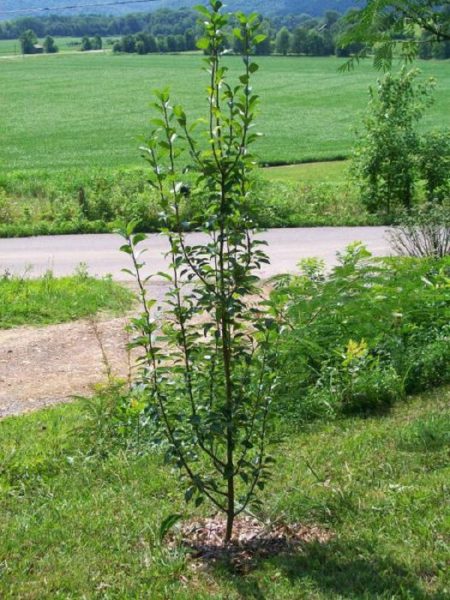
The soil
Pear grows well on almost all soils, clay soils and soils with a minimal amount of fertilizer are not terrible to it. But for growth and productivity it is better to choose fertile soils.
but it is not necessary to plant a tree on the marshy soilwhere groundwater lies close to the roots. From the excess moisture, the root system of the tree suffers and is subject to diseases.
Planting pears Veles
For pear growth, it is important to choose the right planting material.
When buying, you need to pay attention not only to the appearance of the tree, its branches should not be broken, damaged by cracks and diseases. The foliage should have a natural green color, and on the underside of the leaf should be seen streaks - it means that the tree is healthy, and in the nursery there was the right care for it. Also, the root system should not be damaged, the roots have no signs of disease, brownish or gray.
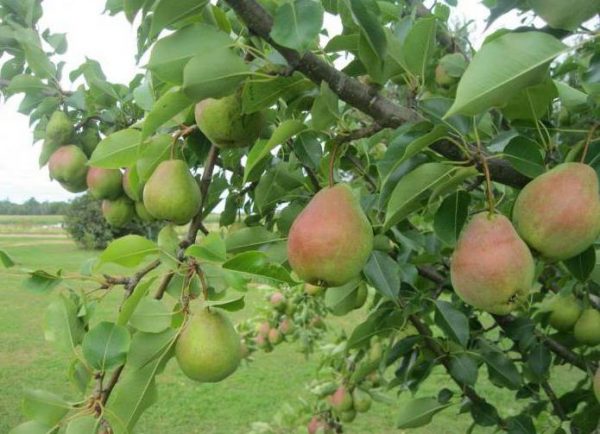
When planting seedlings need to properly prepare the pit. Its size depends on the root system of the seedling, but it is also not worth making a too deep and large hole, you can simply prune the roots. It is dug to a depth of no more than half a meter.Peat or manure is laid on the bottom, the mixture is mixed with the ground.
Now a bucket of water is being poured into the pit so that the earth will sink a little. So that the tree grows smoothly and does not bend to the side, you can immediately install a small wooden handle in the hole. After that, the seedling is placed in a hole, so that the root neck is 8-10 cm above the ground.
Next, the seedling can be tied to the handle, and be sure to water the tree with 2-3 buckets of warm water. Further watering will be needed in 3-4 days. The soil around the cutting should be mulched grass or leaves, so the soil will retain moisture longer.
Pear Velez quickly rooted in new places, she is not afraid of transplants. With proper planting of a tree, after a couple of weeks, new leaves will form on it (if the planting was done in spring), which means that the young tree has taken root in a new place and is ready for growth.
Watering
Watering is important not only for the young seedling, but also for the adult tree. After planting, the ground around the seedling should be watered 2-3 times a week. 2 buckets of warm water will be enough for growth.
An adult plant, especially when it began to bear fruit, also needs watering. With that, it is especially important to shed a tree well in the spring, before flowering. It is necessary to water every week with a small amount of water. The second careful watering should be carried out before the formation of the fruit, it is at this time the pear needs moisture.
You can water the tree in several ways:
First, with the help of rotating mechanisms, i.e. rain method. A drop of water will feed the earth. However, with this method of watering, water gets far around the tree, so there will be much more weeds around.
Secondly, you can dig a small trench around a tree trunk and gently pour water into it.
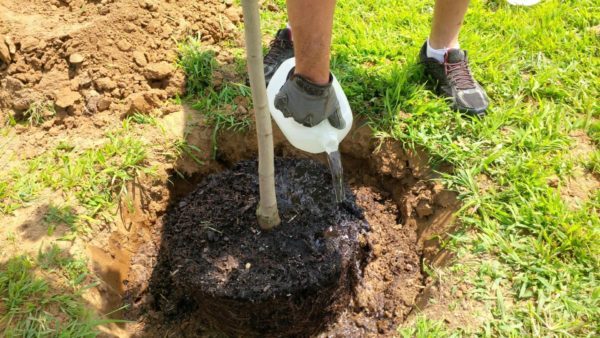
Top dressing
Feeding the pear is done several times a year. The first feeding is made before flowering. It is better to use saltpeter, carbimide or urea.
The second feeding is carried out after flowering. It is good to introduce the so-called "green" fertilizer.A small trench is excavated around the tree, into which food waste, grass, leaves, and manure are placed. The presence of soil is obligatory in this mass.
The third feeding is made in mid-September, it is better to feed the tree with mineral fertilizers, sawdust or ash. But the introduction of nitrogen in the winter is strictly prohibited.
Pruning
Pruning pears is done so that all branches receive light for growth. For the first 2 years, the young tree does not need pruning, it only forms branches, so excessive pruning will only slow the growth of the pear.
But from the 3rd year of growth the pear needs pruning, which can be done with a sharp knife or shears. The first step is cut branches that grow at right angles. Fruits are rarely born on such branches, and besides, they block out the light to the lower-growing shoots. Leaves that grow at an angle of 60-70 degrees, they can withstand heavy fruit in the fall.
The remaining branches are shortened by a third length. The central branch is also trimmed, but its height should exceed the height of other shoots by 20-30 cm.In the 4th year, young shoots are also cut off.
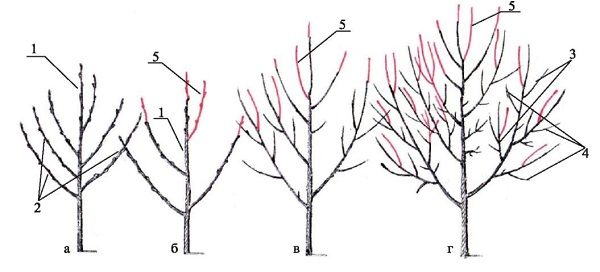
Also, regardless of the tree's growth year, sanitary pruning is done, i.e. broken, dried branches are cut. During the summer, if the branch was infected with diseases or pests, you should not wait for autumn. It is necessary to prune it immediately so that the whole tree does not become infected.
Preparing for the winter
Pear varieties Veles great going through cold winters. But now the preparation of the tree for the winter protects it from low temperatures and pests that overwinter in the roots or bark of the tree.
In the autumn you need to collect all the fruits from the tree. Next you need to gather the foliage around the trunk and dig the ground. This procedure is necessary so that the roots get more oxygen and to remove insects.
Pear Veles a real find for gardeners. Not only does this variety have beautiful and large fruits, so they are not inferior in taste to many other varieties. Tasty, sweet and fleshy fruits spice closer to autumn., long stored on the tree, and in a torn form stored taste for a long time. In addition, the variety does not need special care, is resistant to cold, disease and pests.
